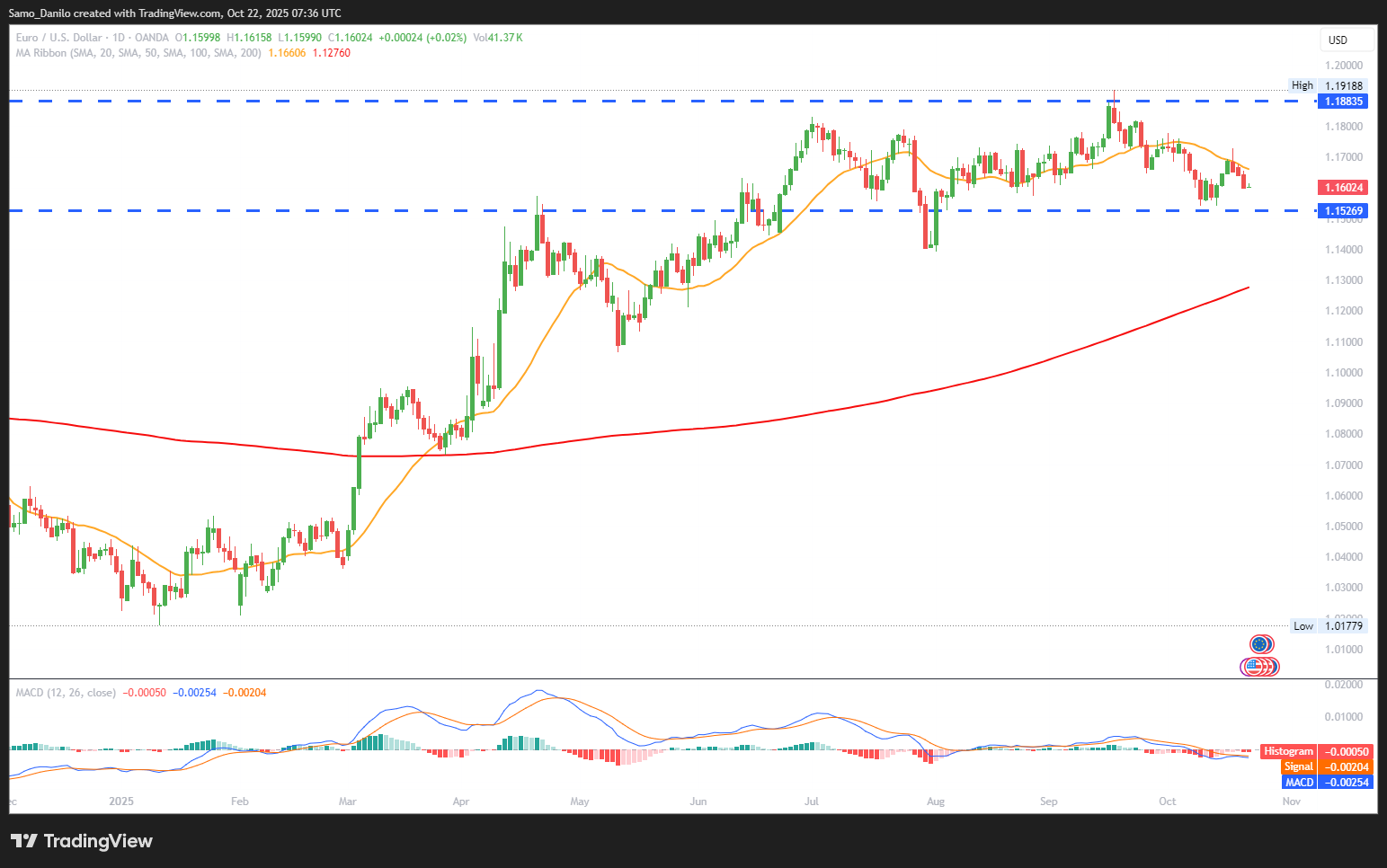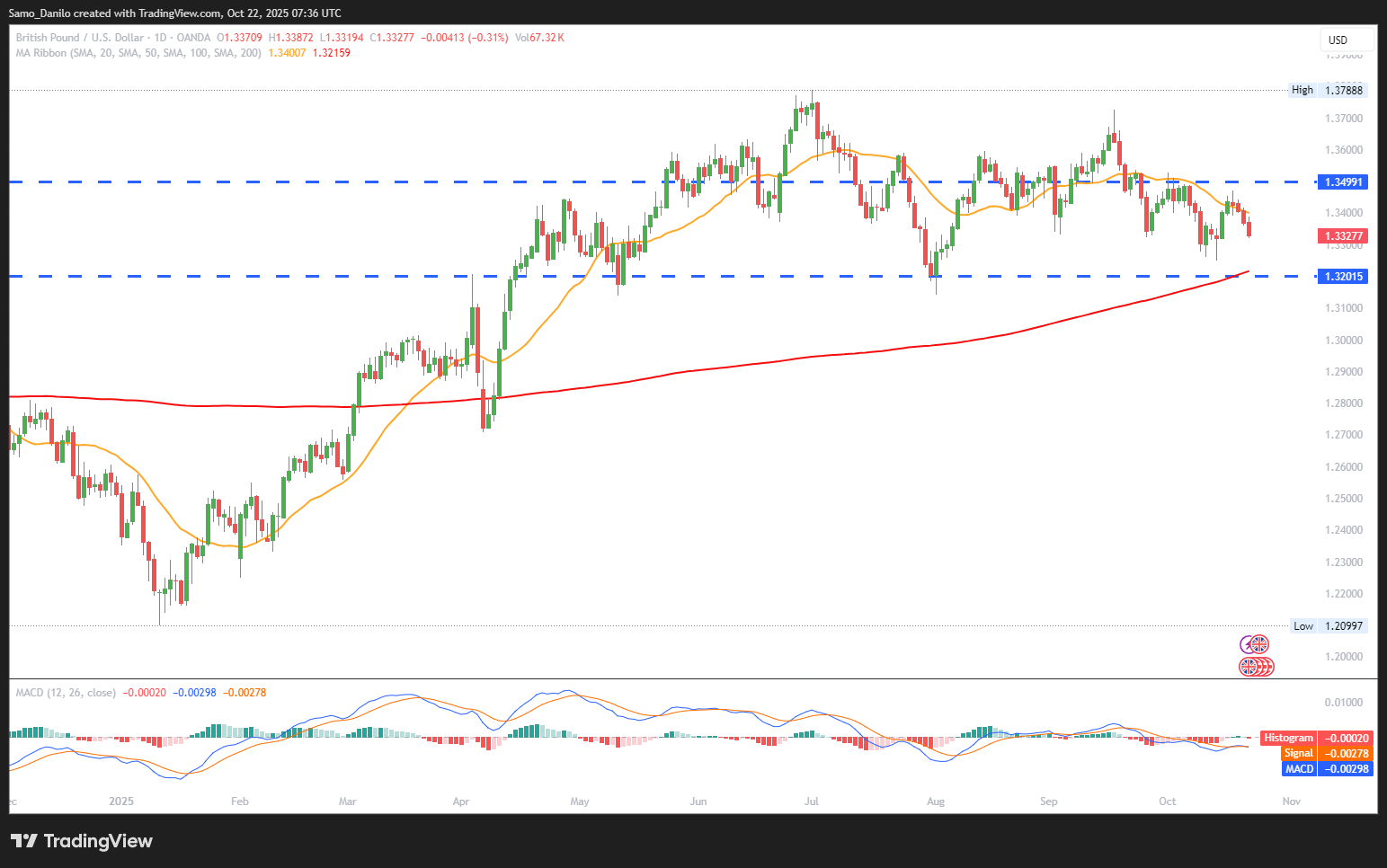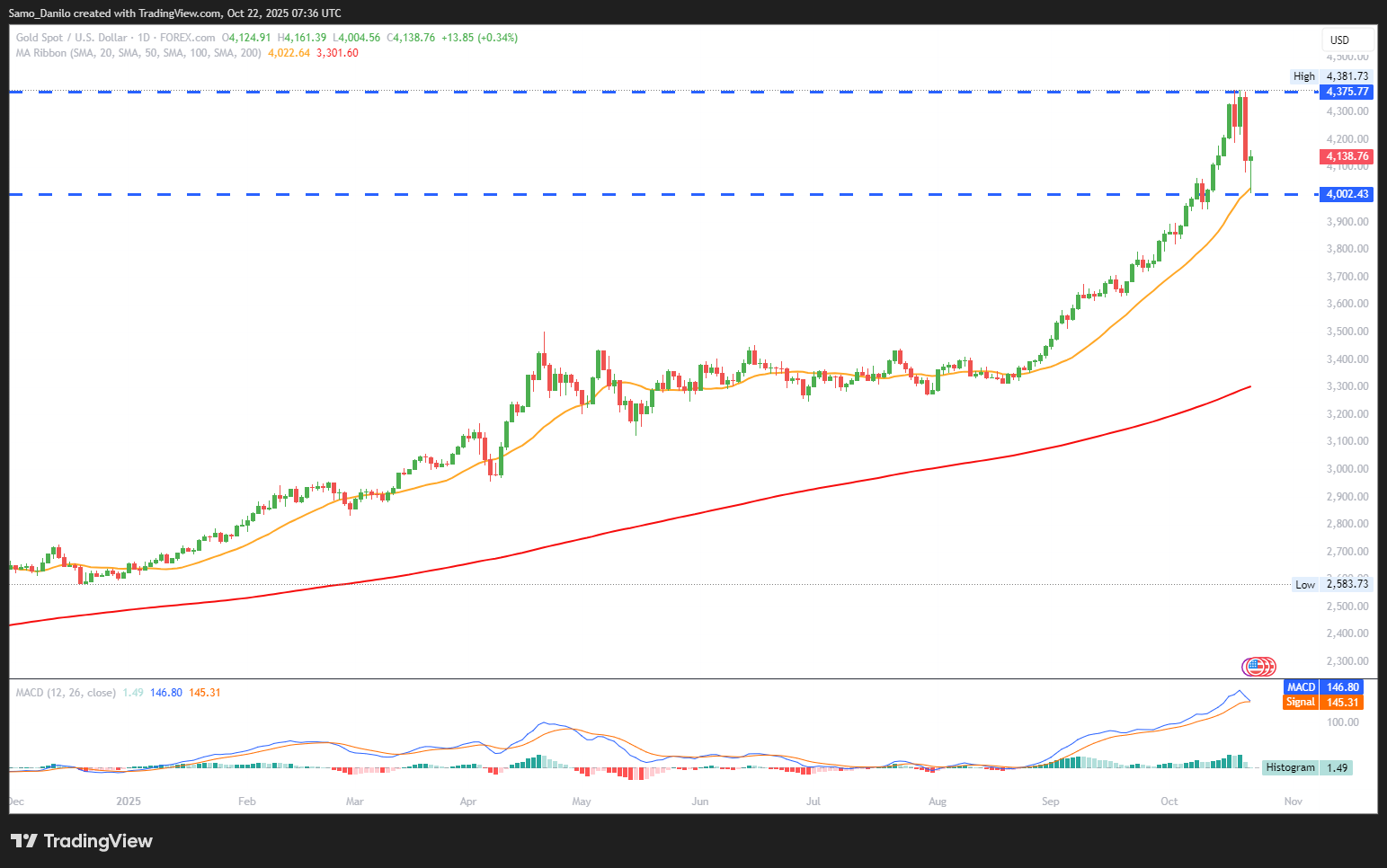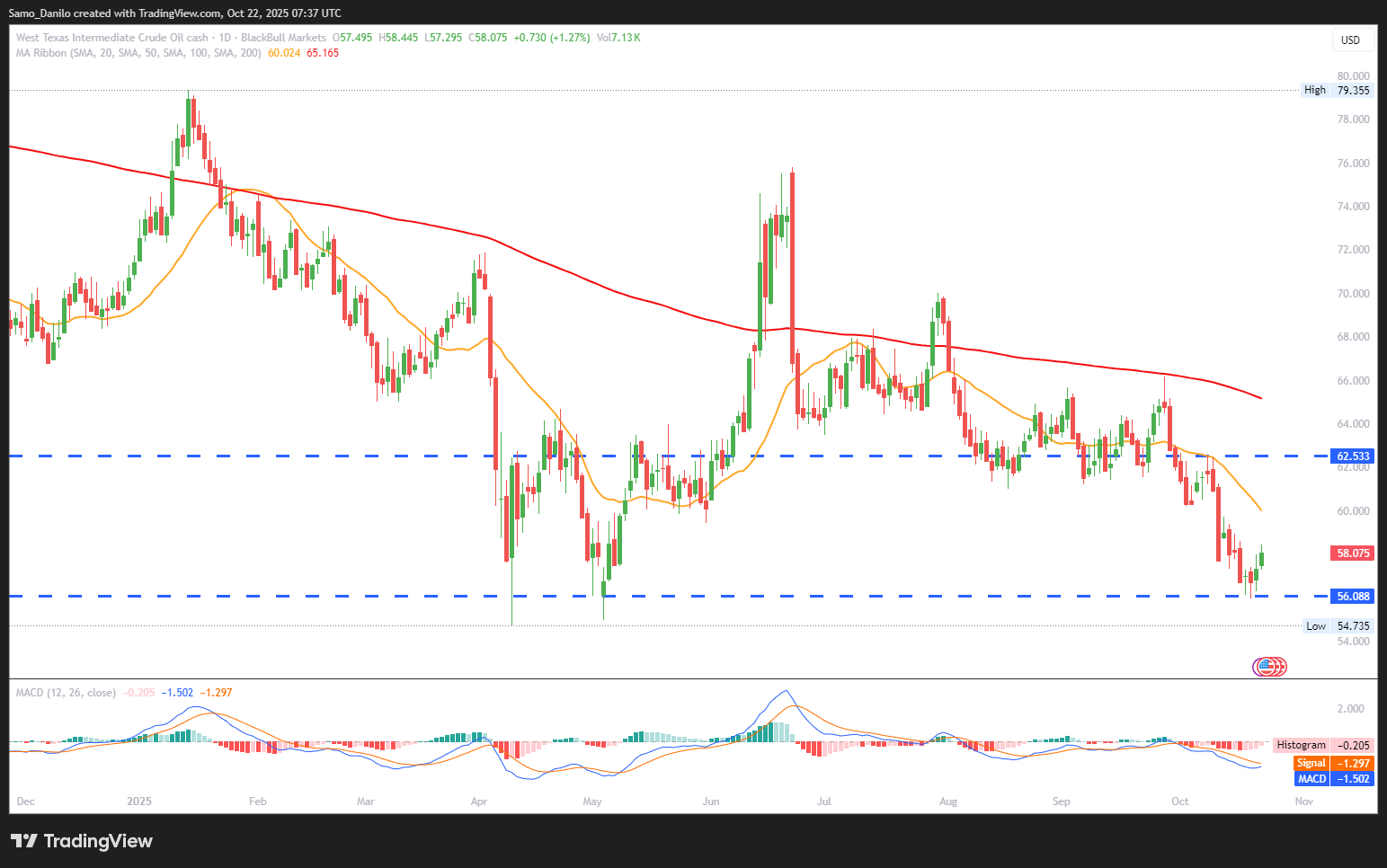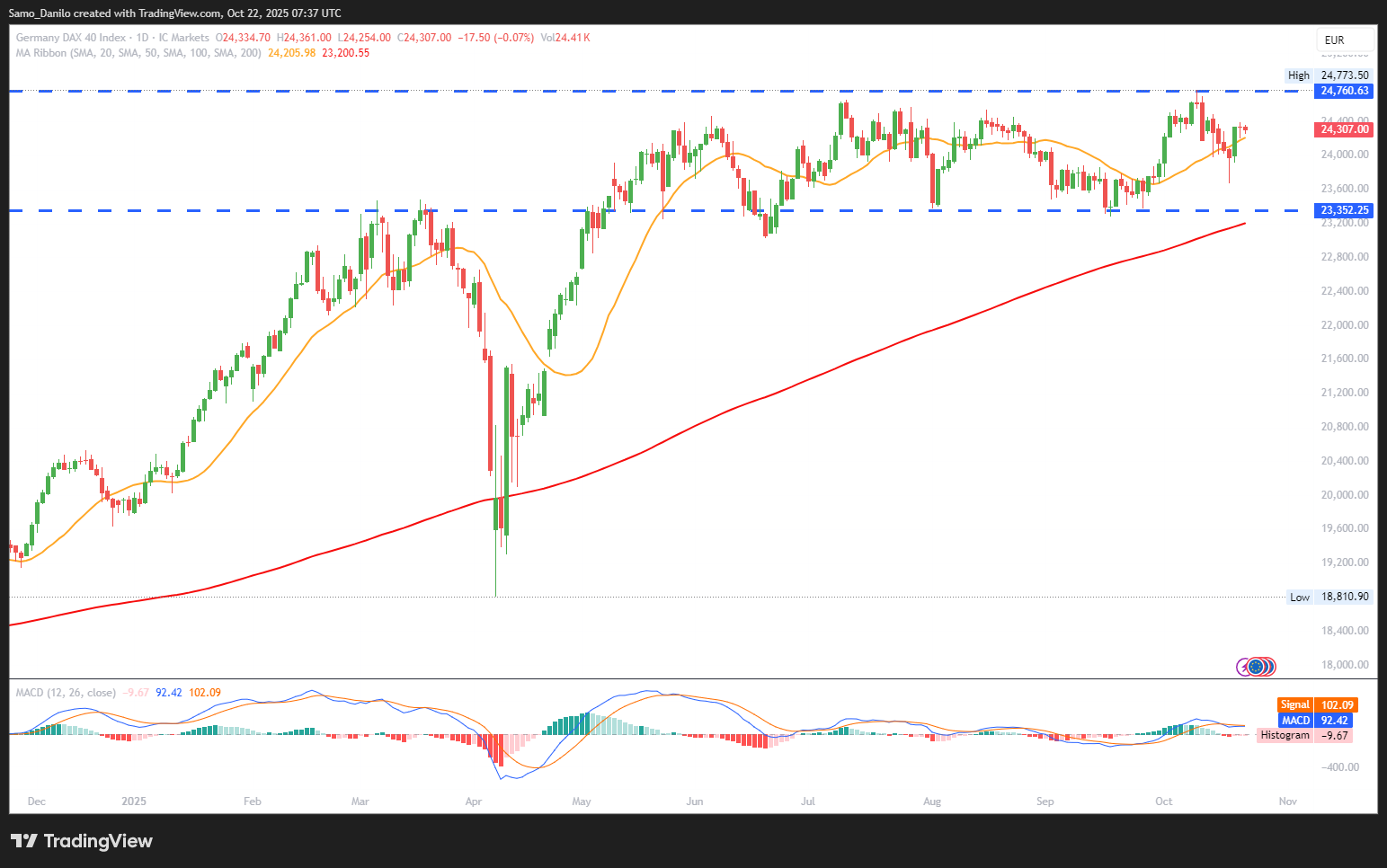EURUSD
- EUR/USD Price: The EUR/USD pair holds steady above 1.1600 in Wednesday’s European session, snapping a three-day losing streak as traders await new catalysts before the ECB enters its blackout period.
- ECB Signals: Eurozone inflation remains near target, with growth holding up modestly. ECB President Christine Lagarde reaffirmed that the central bank is in a “good place”, implying no imminent policy changes.
- Analyst View: In an interview with Paperjam, BCA Research’s Jérémie Peloso characterized the ECB’s recent policy cycle as a “soft landing”, noting that the bank managed to cool inflation without triggering recessionary conditions.
- US-China: Market sentiment improved after President Trump said he expects a consensus with Chinese President Xi during their upcoming meeting in South Korea, tempering safe-haven demand for the USD.
- ECB Speeches: Investors remain cautious ahead of several ECB appearances this week that could shed light on the near-term policy path before the central bank’s pre-meeting quiet period begins Thursday.
Closing statement: The euro shows tentative stabilization as policy clarity and easing geopolitical risks support sentiment. Still, upside momentum may remain capped until traders gain more insight from ECB officials and the next monetary policy meeting.
GBPUSD
- GBP/USD Price: The GBP/USD pair faces renewed selling pressure, trading below 1.3330 in Wednesday’s European session as investors digest fresh UK inflation and fiscal data.
- UK Inflation: The UK CPI rose 3.8% YoY in September, below expectations of 4.0% but still well above the BoE’s 2% target, maintaining pressure on policymakers amid a fragile economic backdrop.
- Fiscal Concerns: The UK government borrowed £7.2 billion more than forecast in the first half of the fiscal year, with the budget deficit reaching £99.8 billion. Surging debt interest payments, up 66% YoY to £9.7 billion in September, further strained public finances.
- Government Shutdown: The US Dollar strengthened as optimism grew that the three-week federal government shutdown could end soon. White House adviser Kevin Hassett said he expects a resolution this week, improving overall risk sentiment.
- Fed Rate: A Reuters poll showed an overwhelming majority of economists (115 out of 117) forecast a 25-bps rate cut to 3.75%-4.00% at the October 29 Fed meeting, underscoring expectations of gradual monetary easing.
Closing statement: The pound remains under pressure as fiscal strains and softer inflation weigh on sentiment, while USD resilience—driven by hopes of government reopening and Fed rate expectations—keeps GBP/USD biased to the downside in the near term.
XAUUSD
- XAU/USD Price: The gold price (XAU/USD) recovered in early European trading, climbing back near $4,150, as investors sought safety amid lingering uncertainty in global trade and geopolitics.
- US-China Meeting: President Trump expressed optimism that his meeting with China’s Xi Jinping could produce a “good deal,” though he admitted it may not occur as planned, tempering market hopes for a breakthrough.
- Bilateral Talks: US Treasury Secretary Scott Bessent is expected to meet with Chinese officials ahead of the broader U.S.-China talks, signaling a potential step toward easing trade tensions that have weighed on risk appetite.
- Geopolitical News: Trump also voiced frustration over delays in talks with Russia’s President Putin, calling off a planned meeting on Ukraine. The development adds uncertainty to geopolitical stability, lending partial support to gold.
- Inflation Data: Traders await the US September CPI report on Friday, which is delayed due to the government shutdown. The release is expected to guide near-term Fed policy expectations and gold’s next directional move.
Closing statement: Gold remains supported by safe-haven flows amid trade and geopolitical uncertainty, but upcoming US inflation data will be pivotal in determining whether XAU/USD sustains its recovery or faces renewed volatility.
CRUDE OIL
- Crude Oil Price: West Texas Intermediate (WTI) crude advanced early Wednesday in European trading, hovering near $58.20 per barrel, building on the prior session’s momentum amid improved demand sentiment and supply concerns.
- SPR Refill: The Trump administration announced a small-scale plan to purchase 1 million barrels for the Strategic Petroleum Reserve (SPR), marking a symbolic move to rebuild emergency stocks, though the impact on overall supply remains minimal.
- Low Reserves: The SPR, depleted after massive releases during the Biden administration, remains near a 40-year low at 395 million barrels, highlighting the fragility of U.S. energy security as strategic inventories stay thin.
- API Data: The American Petroleum Institute (API) reported a 2.98 million-barrel draw in U.S. crude inventories, defying forecasts of a build and signaling tighter near-term supply, which underpins bullish market sentiment.
- Geopolitical Risks: A Ukrainian drone strike on a Russian gas facility in Orenburg disrupted operations in neighboring Kazakhstan, while the EU’s phased exit from Russian gas by 2027 continues to reshape regional energy flows.
Closing statement: WTI crude remains supported by inventory draws and geopolitical disruptions, though the modest U.S. SPR refill offers limited relief to long-term supply risks. Traders will watch upcoming EIA data and global risk developments for clues on whether the rally can sustain above the $58 threshold.
DAX
- DAX Price: Germany’s DAX index continued its upward momentum this week, trading comfortably above the 24,000 mark, supported by strong quarterly earnings across key sectors that have boosted investor sentiment.
- EU Budget: Berlin announced its support for the European Commission’s new seven-year budget plan, emphasizing a performance-based funding model and warning it would block any deal that fails to link financial aid with measurable results.
- Chancellor Pledge: Chancellor Friedrich Merz reaffirmed his commitment to sustaining Germany’s industrial core, vowing targeted support for chemicals, mining, and energy firms as they transition toward climate neutrality, reinforcing his pro-industry stance.
- Corporate Insolvencies: Germany faces its worst wave of bankruptcies in over a decade, with an average of 60 companies filing daily. September saw a 10.4% rise in insolvencies, and analysts warn that over 22,000 businesses could collapse by 2025 amid economic stagnation and higher financing costs.
- SAP Earnings: Investors await SAP’s post-market report on Wednesday, expected to provide crucial insights into the health of Germany’s tech sector and broader corporate profitability trends during the current reporting season.
Closing statement: The DAX’s resilience above 24,000 reflects robust earnings and government support for industrial recovery, though rising insolvencies and economic headwinds remain key risks. Market attention now turns to SAP’s results for signals on corporate momentum heading into year-end.
